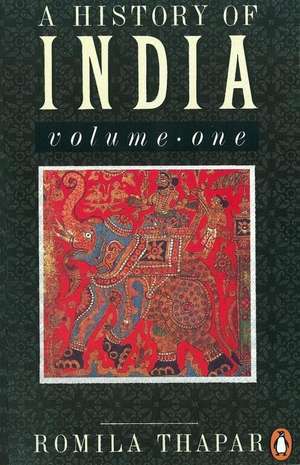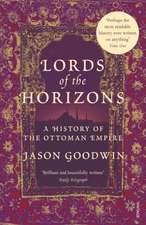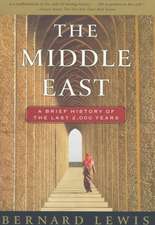A History of India
Autor Romila Thaparen Limba Engleză Paperback – 27 iun 1990
Preț: 82.77 lei
Nou
Puncte Express: 124
Preț estimativ în valută:
15.84€ • 17.20$ • 13.31£
15.84€ • 17.20$ • 13.31£
Carte tipărită la comandă
Livrare economică 22 aprilie-06 mai
Preluare comenzi: 021 569.72.76
Specificații
ISBN-13: 9780140138351
ISBN-10: 0140138358
Pagini: 384
Dimensiuni: 129 x 198 x 22 mm
Greutate: 0.3 kg
Ediția:Revised
Editura: Penguin Books
Colecția Penguin
Locul publicării:London, United Kingdom
ISBN-10: 0140138358
Pagini: 384
Dimensiuni: 129 x 198 x 22 mm
Greutate: 0.3 kg
Ediția:Revised
Editura: Penguin Books
Colecția Penguin
Locul publicării:London, United Kingdom
Notă biografică
Romila Thapar
Cuprins
Acknowledgements
Preface
1. The Antecedents
The discovery of India; changing approaches to Indian history; the archaeological background
2. The Impact of Aryan Culture
Sources of evidence; The political organizations of the Aryan tribes; caste and other social institutions; Vedic relgion
3. Republics and Kingdoms c. 600-321 B.C.
Evolving political patterns; the rise of the kingdom of Magadha; the rule of the Nandas; North-western India and contacts with Persia; the growth of towns; the rise of heterodox sects; Jainism and Buddhism
4. The Emergence of Empire 321-185 B.C.
The Mauryan kings; Mauryan contacts with neighbouring states; society and economic activity; Mauryan administration; Ashoka and his policy of Dhamma; the decline of the Mauryan empire
5. The Disintegration of Empire c. 200 B.C.-A.D. 300
The political fragmentation of the sub-continent: the Shunga dynasty, King Kharavela of Kalinga, The Indo-Greek kings, The Shakas, The Kushanas, The Satavhana dynasty, South Indian Kingdoms; trade routes and communications
6. The Rise of the Mercantile Community c. 200 B.C.-A.D.300
Guilds; Roman trade with south India; interation of Indian and Hellenic ideas in northern India; India's contacts with China and south-east Asia; changes in society; education and literature; Buddhist art and architecture; Mahayana Buddhism; developments in Hinduism; the coming of Christianity
7. The Evolution of the "Classical" Pattern c. A.D. 300-700
The rule of the Guptas; Hun invasions; some post-Gupta dynasties; the reign of Harsha; changing agrarian relations; trade; the pattern of living; education and learning; Hindu art and architecture; development in Buddhism; changes in Hinduism; philosophical schools; Indian contacts with China and south-east Asia
8. Conflict in the Southern Kingdoms c. A.D. 500-900
The Chalukya, Pallava, and Pandya conflicts; political organization and administration; the Agrarian system; the status of the brahman; the philosophy of Shankara; the growth of Tamil literature; the Tamil devotional cult; mural painting in the Deccan; temple architecture
9. The South in the Ascendant c. A.D. 900-1300
The rise of the Cholas; Chola administration; the village in the Chola economy; trade; the role of the temple in Chola society; the development of the languages of the peninsula; popular cults and sects; the philosophy of Ramanuja and Madhva; architecture and sculpture
10. The Beginnings of Regional States in Northern India c. A.D. 700-1200
Political struggle between the Rashtrakutas, Pratiharas, and Palas; the arrival of the Arabs in Sind; rise of new kingdoms; growth of Raiput power; campaigns of Mahmud of Ghazni; the Afghan army; Muhammad Ghuri
11. Feudalism in the Regional States c. A.D. 800-1200
Beginnings of regional loyalty; emerging pattern of agrarian relations; social structure; literature in Sanskrit and in the newly developing languages; temples and sculpture; changes in Hinduism, the devotional cult, and the Tantric sects; decline of Buddhism; the arrival of the Sufis
12. The Re-alignment of Regional Kingdoms c. A.D. 1200-1526
Source material on the Delhi Sultanate; the Slave dynasty and the Khalji dynasty; political organization; the Tughluq dynasty; relations between the rulers and the ruled; the Sayyid and Lodi dynasties; the kingdoms of Gujarat, Mewar, Marwar, and Bengal
13. Assimilation on Trial c. A.D. 1200-1526
Trends in the impact of Islam on India; balance of power between king and theologian; administrative structure of the Sultanate; the economy; the social framework; religious expression as seen in the Bhakti movement and the Sufis; new languages and literatures; miniature painting; Islamic architecture
>/b>
The rise of the Vijayanagara and Bahmani kingdoms in the Deccan; changes in the socio-economic background; trade; religion
Chronological table
Glossary
References to quotations
General bibliography
Bibliographical note on sources
Index
Preface
1. The Antecedents
The discovery of India; changing approaches to Indian history; the archaeological background
2. The Impact of Aryan Culture
Sources of evidence; The political organizations of the Aryan tribes; caste and other social institutions; Vedic relgion
3. Republics and Kingdoms c. 600-321 B.C.
Evolving political patterns; the rise of the kingdom of Magadha; the rule of the Nandas; North-western India and contacts with Persia; the growth of towns; the rise of heterodox sects; Jainism and Buddhism
4. The Emergence of Empire 321-185 B.C.
The Mauryan kings; Mauryan contacts with neighbouring states; society and economic activity; Mauryan administration; Ashoka and his policy of Dhamma; the decline of the Mauryan empire
5. The Disintegration of Empire c. 200 B.C.-A.D. 300
The political fragmentation of the sub-continent: the Shunga dynasty, King Kharavela of Kalinga, The Indo-Greek kings, The Shakas, The Kushanas, The Satavhana dynasty, South Indian Kingdoms; trade routes and communications
6. The Rise of the Mercantile Community c. 200 B.C.-A.D.300
Guilds; Roman trade with south India; interation of Indian and Hellenic ideas in northern India; India's contacts with China and south-east Asia; changes in society; education and literature; Buddhist art and architecture; Mahayana Buddhism; developments in Hinduism; the coming of Christianity
7. The Evolution of the "Classical" Pattern c. A.D. 300-700
The rule of the Guptas; Hun invasions; some post-Gupta dynasties; the reign of Harsha; changing agrarian relations; trade; the pattern of living; education and learning; Hindu art and architecture; development in Buddhism; changes in Hinduism; philosophical schools; Indian contacts with China and south-east Asia
8. Conflict in the Southern Kingdoms c. A.D. 500-900
The Chalukya, Pallava, and Pandya conflicts; political organization and administration; the Agrarian system; the status of the brahman; the philosophy of Shankara; the growth of Tamil literature; the Tamil devotional cult; mural painting in the Deccan; temple architecture
9. The South in the Ascendant c. A.D. 900-1300
The rise of the Cholas; Chola administration; the village in the Chola economy; trade; the role of the temple in Chola society; the development of the languages of the peninsula; popular cults and sects; the philosophy of Ramanuja and Madhva; architecture and sculpture
10. The Beginnings of Regional States in Northern India c. A.D. 700-1200
Political struggle between the Rashtrakutas, Pratiharas, and Palas; the arrival of the Arabs in Sind; rise of new kingdoms; growth of Raiput power; campaigns of Mahmud of Ghazni; the Afghan army; Muhammad Ghuri
11. Feudalism in the Regional States c. A.D. 800-1200
Beginnings of regional loyalty; emerging pattern of agrarian relations; social structure; literature in Sanskrit and in the newly developing languages; temples and sculpture; changes in Hinduism, the devotional cult, and the Tantric sects; decline of Buddhism; the arrival of the Sufis
12. The Re-alignment of Regional Kingdoms c. A.D. 1200-1526
Source material on the Delhi Sultanate; the Slave dynasty and the Khalji dynasty; political organization; the Tughluq dynasty; relations between the rulers and the ruled; the Sayyid and Lodi dynasties; the kingdoms of Gujarat, Mewar, Marwar, and Bengal
13. Assimilation on Trial c. A.D. 1200-1526
Trends in the impact of Islam on India; balance of power between king and theologian; administrative structure of the Sultanate; the economy; the social framework; religious expression as seen in the Bhakti movement and the Sufis; new languages and literatures; miniature painting; Islamic architecture
>/b>
The rise of the Vijayanagara and Bahmani kingdoms in the Deccan; changes in the socio-economic background; trade; religion
Chronological table
Glossary
References to quotations
General bibliography
Bibliographical note on sources
Index
















